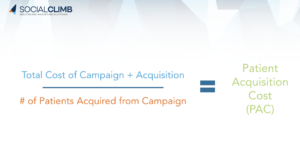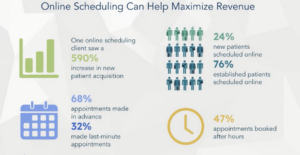The Win-Win Scheduling Strategy: Reduce Acquisition Costs & Meet Patient Demands
By Chloe From Clearwave | April 10, 2024
Drop your patient acquisition costs by first understanding how to calculate and evaluate them. Then uncover cost-efficient ways to boost patient acquisition! From there, you can build your win-win strategy.
Is Marketing Essential to Patient Growth?
In today’s competitive patient market, healthcare practices must build awareness via strategic scheduling and marketing strategies to excel in patient acquisition, retention and practice growth. And – no matter the industry – marketing isn’t a cheap endeavor.
How do you know if your marketing budget is being put to good use? Are marketing campaigns providing a strong return on investment (ROI)? What are some best practices to create patient interest that translates into booked appointments?
To answer these questions, we recently participated in a live discussion on “Minimizing Patient Acquisition Costs“. Here are the top takeaways!
How to Calculate Patient Acquisition Cost
In healthcare, one of the most impactful ways to measure the success of your marketing initiatives is to calculate patient acquisition cost (PAC) – or the amount of money you’re spending to acquire each new patient.
Understanding PAC is critical in today’s economic environment and competitive healthcare landscape. Growing practices cannot afford to spend endless dollars on marketing without seeing a return on their investment. Insight into PAC can help inform future investments and ensure good business decisions, which ensure that you’re cost-effectively building awareness and attracting patients to drive practice growth.
Here’s the PAC formula:
Now let’s run through an example:
Let’s say you spent $5,000 on a paid social media campaign generating awareness for LASIK eye surgery, and as a result, your practice captured 20 new patients through your online scheduling software. You would calculate the PAC of this initiative in this way:
$5,000 +200 ÷ 20 = $260 per patient
Let’s break down each of these components.
When we refer to the cost of the campaign, we’re talking about the cumulative cost of the mix of marketing tactics you use in a single campaign. While there are earned media tactics that can be used to acquire new patients for little to no cost (e.g., SEO, reputation and organic social media), many marketing tactics require budget – from brand and search ads, to email campaigns and postcards, to predictive targeting and paid social. If a campaign used postcards and search ads, for example, then the cost for each would be added together to get the total cost of the campaign.
The acquisition method refers to how practices convert interest from prospects into patients that visit the office. Practices generally use one of two conversion methods: they ask patients to call the office to schedule an appointment or leverage patient self-scheduling platforms to book patients 24/7. While both of manual and digital booking options contribute to your PAC, online scheduling is a considerably more cost-effective option because it removes the incurred cost associated with the human element.
Want to dig deeper into how your marketing efforts are paying off? Calculate your PAC here today!
Minimize PAC by Optimizing Patient Booking
The biggest opportunity to convert prospects into patients is through a seamless scheduling approach. Think back to the two common conversion methods used by practices: phone and online scheduling. Online scheduling puts your booking process on autopilot, dropping staff workloads and bringing in patients 24/7. By giving patients the ability to book appointments after office hours close and on weekends, you can meet patient demands for scheduling and reduce adandoned bookings. When patients have to call your office to book, you increase the liklihood of them booking elese where or avoiding seeing a provider altogether…and with changing patient expectations for booking this risk is increasing!
Consumers have grown accustomed to having digital, instant access across all aspects of their lives – from booking a flight to ordering dinner, and they now want the same experience in their healthcare interactions. These changing expectations have caused demand for online scheduling to skyrocket over last few years, even across the age sectors. Consider these statistics:
- 90% of patients would consider abandoning a provider that doesn’t offer digital access.
- 99% of millennials and 97% of Gen Xers and 92% of Baby Boomers would use online scheduling if it were offered.
People no longer have the time or the patience to pick up the phone and wait on hold to schedule an appointment. On average, it takes a patient 8 minutes to schedule an appointment via phone. In many cases, it can even be much longer, for example if a practice is short staffed, on Monday mornings following a long weekend or during lunch hour. Practices that only offer phone scheduling are at risk of losing patients that no longer want to use this traditional method.
Concerned that your call abandonment rate may be costing you patients? Calculate it here.
Additionally, phone scheduling means appointments can only be booked during limited office hours, causing practices to lose out on patients who want to schedule after hours or on the weekends. All of these factors equate to minimal patient conversation rates and an increased PAC.
Digital, patient self-scheduling, on the other hand, meets patient demand for flexibility to book appointments online anytime, anywhere, without human interaction. Thus, integrating online scheduling into earned and paid marketing tactics can optimize conversions to decrease PAC while increasing practice revenue and growth.
How Practices Are Seeing More Patients Without Adding Marketing Costs
It’s one thing to talk about the benefits of digital, patient self-scheduling, but it’s another thing entirely to see it in action in the real world. The proof is in the numbers, here are some results high-growth practices are seeing after implementing online scheduling. Watch the conversation to see how these clients made it happen.
Rethink Your Patient Acquisition Strategies to Drive Growth
The bottom line is that online scheduling is no longer a “nice-to-have” feature, it’s a critical component in a practice’s patient acquisition, retention and growth strategy. Watch the 20-minute conversation on, “Minimizing Patient Acquisition Costs,” and start seeing more patients than ever before.
Learn more about SocialClimb, the Healthcare Marketing Platform here.
Recommended for you
Related Posts
Patient Self-Scheduling Adoption Reaches New Heights at 87%
Reading Time: 3 minutesBeyond Utilization, Clearwave Data Unveils Features That Increase Patient Acquisition by 174% and Save 1,500 Staff Hours ATLANTA, April 2, 2025…
From Click to Care: 3 Ways to Increase Patient Acquisition at Lower Costs
Reading Time: 3 minutesBy Blakely Roth | March 12, 2025 In today’s competitive healthcare environment, specialty practices must find innovative ways to attract…
How ENT and Otolaryngology Practices are Getting More Patients
Reading Time: 5 minutesBy Chloe From Clearwave | February 3, 2025 Modern practices are discovering that traditional scheduling methods simply can’t keep up…






